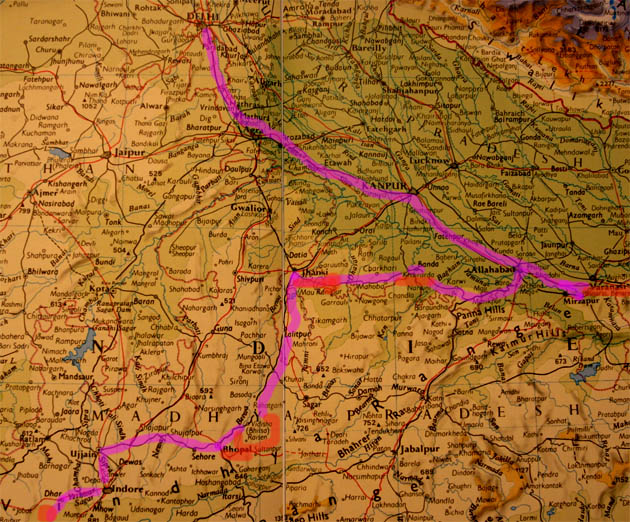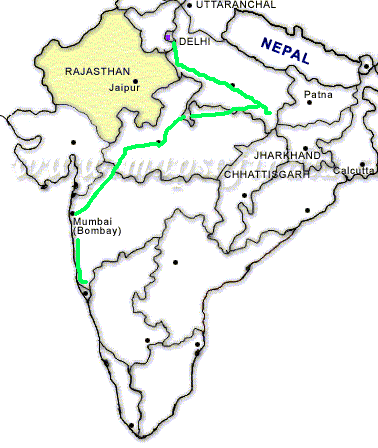Introduction
This is an abridged description of a trip to India in November/December 2004. The intention is to give a first hand personal experience of how we, Manfred and myself, did get to and through the country from Delhi via Varanasi, Sanchi, Khajuraho, Orchha, Mandu, Pune to Goa and back to Delhi. Despite the fact that we did not book anything in advance at all (except for the flight to India) and that we covered about 3000 km one way within 26 days with trains and buses, it still was a very good trip with no hassle whatsoever.
Only because of the time frame we planned a couple of days ahead: What places or actions are a must or nice to see or to experience? What means of transport? Plane, train or bus? Are seats or sleepers available? Getting a seat on a bus next day or even same day wasn't a problem, but buses take longer and are inconvenient during the night or a whole day on the road. Seats on flights and trains should be reserved at least one day in advance.
Also, two to three days contingency ought to be build into the itinerary, not necessarily for each travelling leg but still carried along until the final destination is reached in time. And the closer you get to the final destination the less contingency is needed (ok, all the same as usual). Only the flight from Goa back to Delhi via Mumbay we booked two weeks in advance because of the Christmas season (yes, even in Hindu-India)
Getting from Cologne to Delhi
The whole trip from Cologne to Delhi and return with Lufthansa was a good deal for 500 Euro (including tax), though the first leg to Frankfurt was with the "Lufthansa-Train". Even if we could already check-in at the main railway station in Cologne, we almost couldn't get a seat, because the wagon according to our seat reservation ticket was not hooked up to our train. We forgot to complain on return. Anyway, the direct flight from Frankfurt to Delhi was ok.
We arrived in Delhi on November 25th, 2004 in the very early morning hours, and that was a problem: Firstly, we went by taxi from the airport to an area close to the New Delhi railway station where Manfred wanted to stay in a place he knew, but it was full. Secondly, most of all the other sleep-ins in the same area were shut and the guard was sleeping, thirdly we found a last one, really the last but the only choice, the
Hotel Ajanta
36, Arakashan Road
Pahar Ganji, New Delhi
Website:tourism-india.com/hotelajanta
|
which was very filthy and the price of 600 rupees plus tax (11 Euro) for that kind of room outrageous. Never ever take that hotel (but it was recommended by Lonely Planet !!!!).
Though, we were so tired that we slept till noon but then we hurried to the railway station in order to get out of Delhi as soon as possible (rather stay there again at the end of our trip, not in the same hotel, of course). On the way to the station we were already encountered by some touts. One lured us to a one man on a second floor travel agency opposite the railway station who wanted to sell us train tickets for the same day. However, I was a little suspicious so I suggested to go to the station first.
There we asked around for the reservation office we finally found in a hall on the second floor full with people waiting for their turn. We did not know how long this will take but we tried. The system was easy: sitting next on a horse-shoe bench and moving one further up until it was your turn to move to one of the reservations desks.
And we were lucky to get "sleeper" tickets for the same evening with the Purshottam Express to Mughal Sarai, the closest station to Varanasi (the old Benares) for 2234 rupees (40 Euro for two). The clerk was very kind, and he knew it, because after he handed us the tickets he asked us to go to his supervisor's office to tell him about the nice treatment we had experienced. Maybe he wanted another salary increase or whatever appraisal system was in place for that.
There was no need to change any money for the fare because we did this already at the airport, where we did get 17.235 rupees for 300 Euro (exchange rate 57,45).
Varanasi
Varanasi is one of the holiest places in India, where Hindus can wash away their sins. It is also a "good" place to die, because it will also mean that the soul will be liberated from the cycle of birth and death. However, we didn't sin and we did not want to die either. We were just curious about this place and how the Indians are going after their belief.
But first we had to find a hotel. From the railway station we went by a auto-rickshaw directly to the Cantonment area, north of the Varanasi Junction railway (another station serving another route), which was, according to the Lonely Planet, where the better hotels were located, like Radisson and Clark. But we went there not just for them. It also was a nice and quiet neighborhood. We looked at several of the cheaper ones in one of the side streets and finally settled down in the
Hotel Shalimar
with a room rate of 200 rupees (3.50 Euro). The other hotel close by I can recommend was the
Hotel Surya
with a good restaurant in a pleasant big garden.
It would have been another interesting opportunity to stay right in the middle or along the ghats of the old town in one of the many budget hotels, but we rather only go there and come back for a good night's sleep. And that's what we did. We had a map of the city and could thus easily find our way. And then we saw it, the famous Ganges river.
Click the small picture to get it large
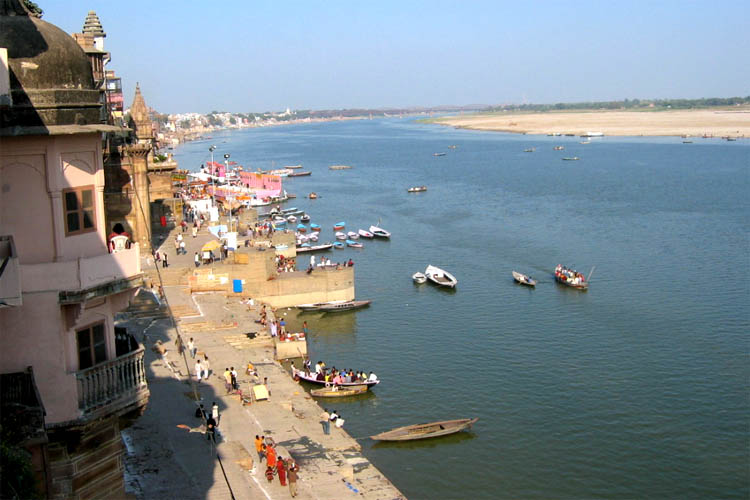
| Finally, the Ganges, can't miss it
|
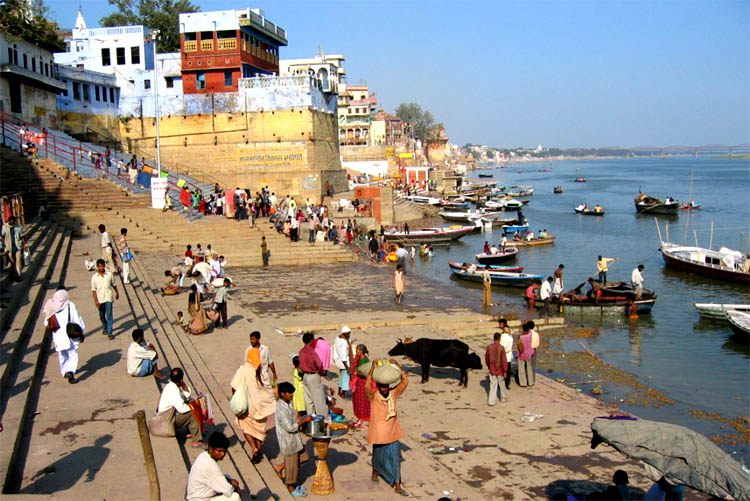
| every Hindu is supposed to visit
|
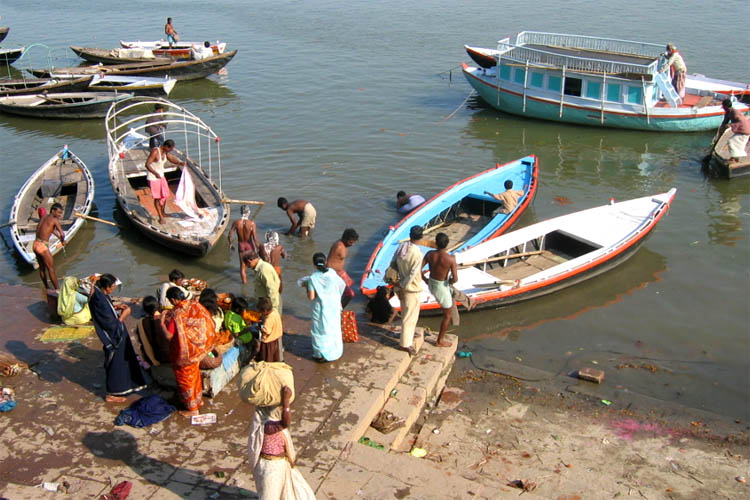
| There are passengers abound
|
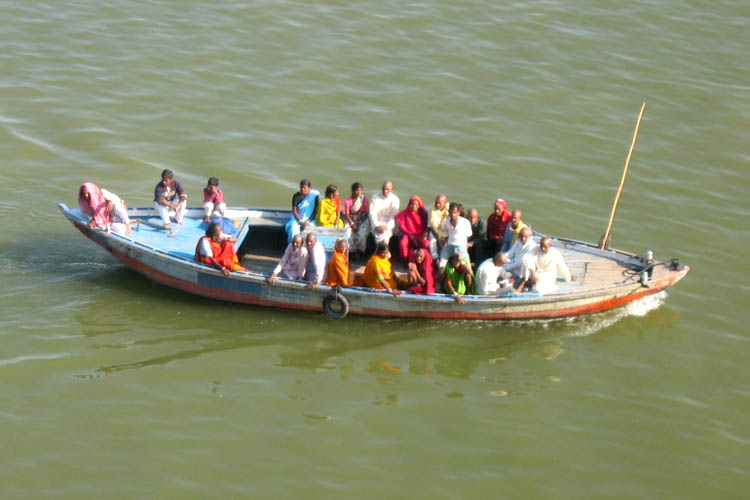
| taking a boat trip to look around
|
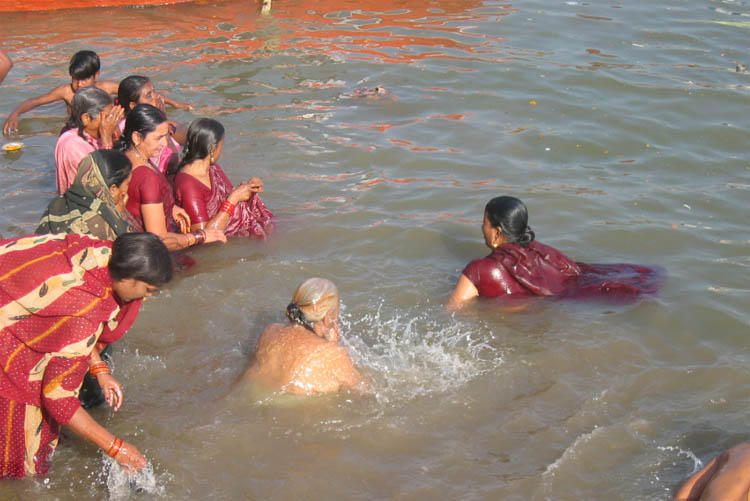
| Some taking a bath in the holy water
|
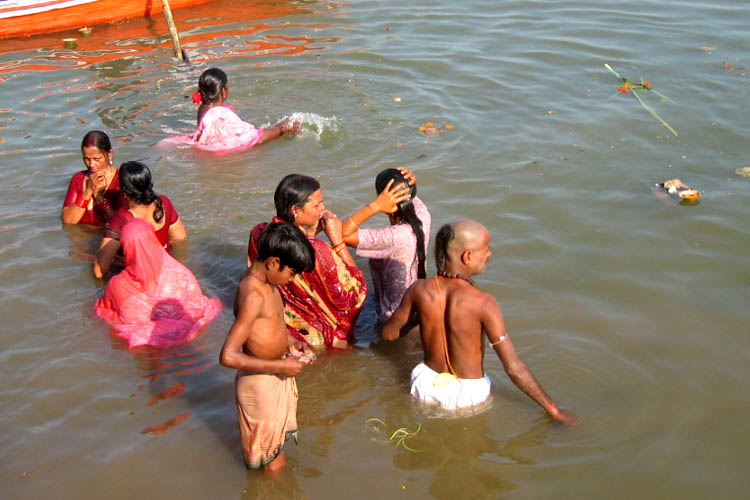
| holy shit, full with kolibacter
|
There are around 100 ghats, the riverbank's platforms with stairs going down to and into the river. Most are used for bathing and few for the cremation of the dead bodies (photo taking not permitted). Of unknown reason to me, the latter are located a little up the river, so the ashes or whatever is left of the body and swept into the river will pass all the bathing people down the river, sometimes a charcoaled head or a half burned arm sticking out and seemingly still rowing the waves. It does not mean the outcasts ("cremators") are only doing half the job, but some relatives of the deceased can not afford (or they did not inherit enough to pay for) all the wood to completely burn the body. I have seen the scales which are used to exactly weigh the wood to be used.
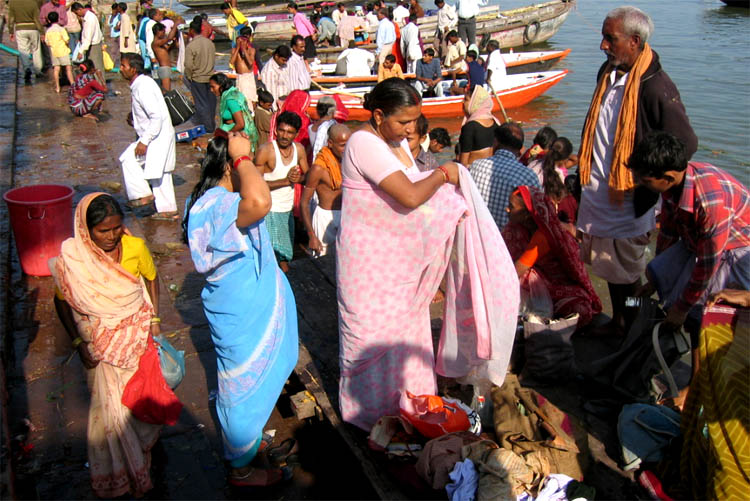
| From the bath getting clean was an illusion
|

| A holy man will give you proper absolution?
|

| More holy men sitting around
|
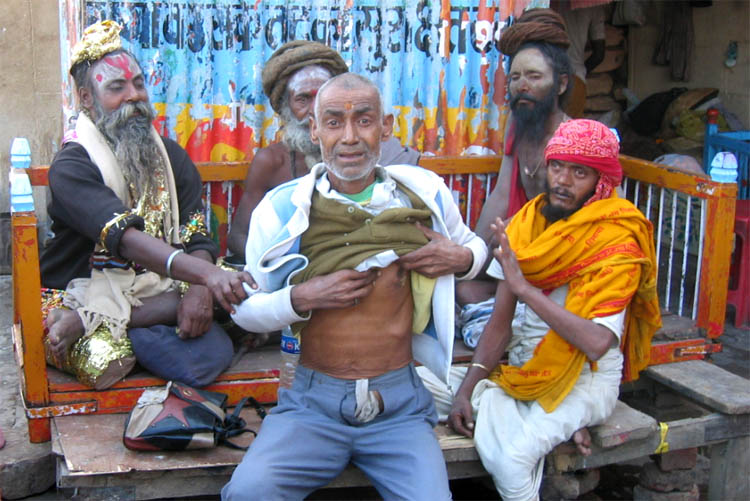
| You know what he is up to? I don't!
|

| Discussing things down on earth
|
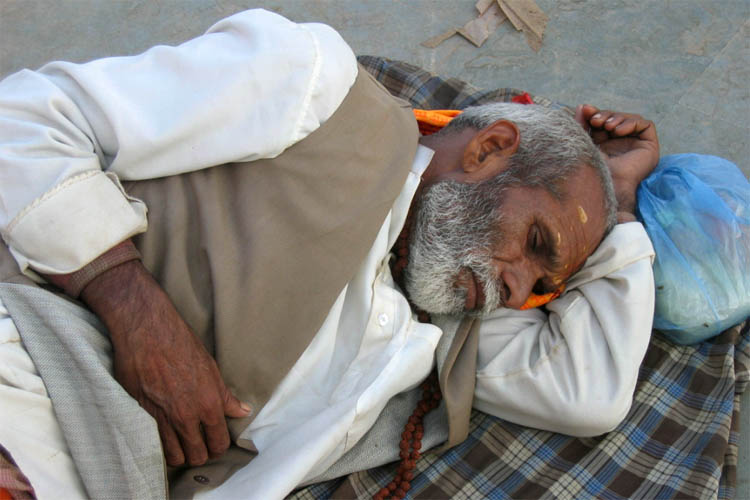
| and he seemed to be in heaven
|
Late afternoon now. The sun is slowly going down. Shadows are getting longer. Something's in the air, I cannot describe. Everything looks so peaceful but something is going on. Some people are preparing for something, others are waiting for something. What is it? Soon we will find out.
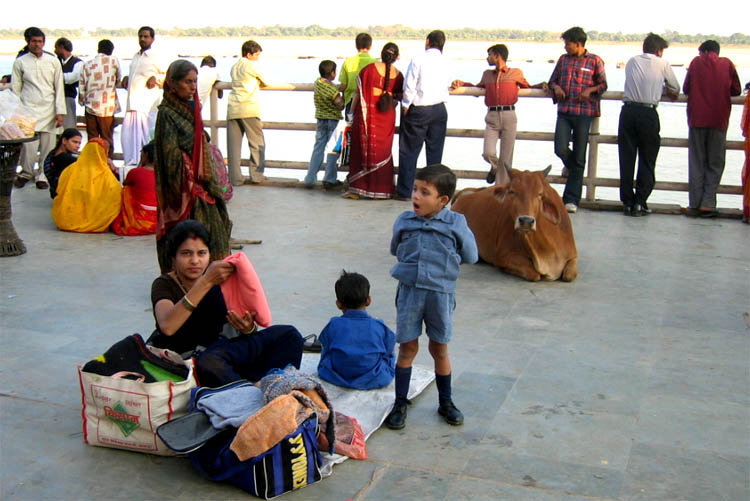
| What are they waiting for, among a cow?
|

| The police is already on alert now
|
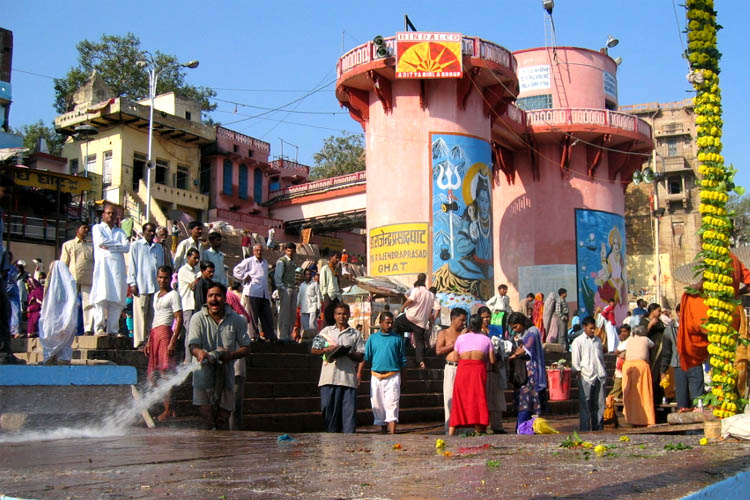
| A ghat is being hosed clean
|
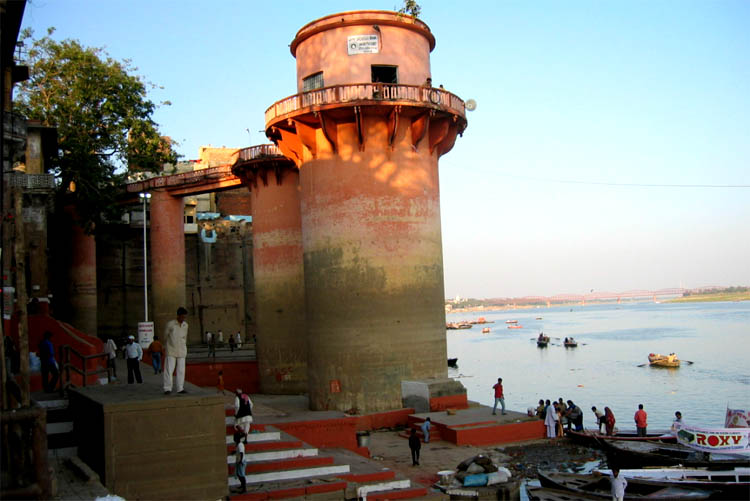
| The sunset is closing in
|
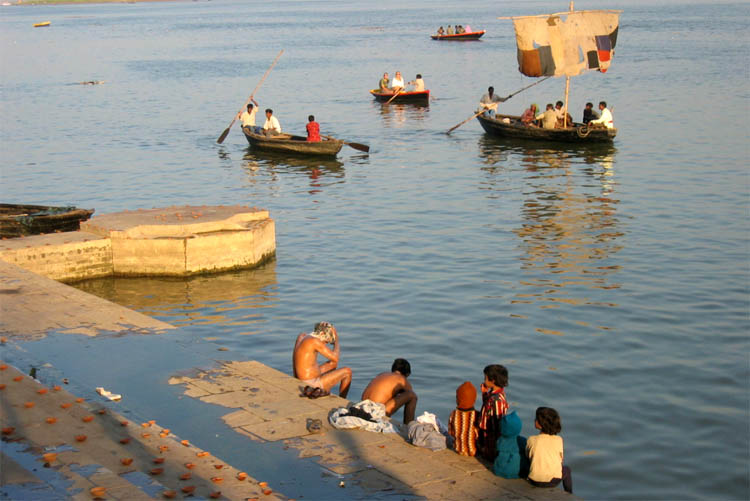
| Still, washing men cannot do wrong
|
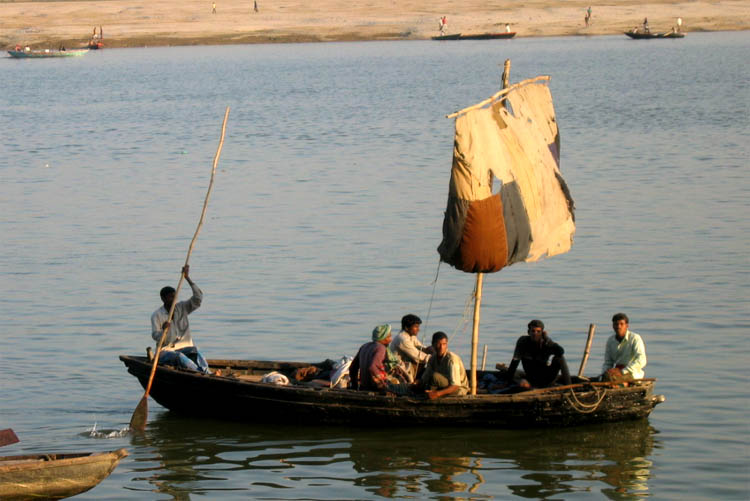
| while a boat is sailing along
|
Ok, that was all about the preparation for a religious festival. More and more people are coming to the old town to join and watch and pray a lot. But we did not stay for long, because we had ordered a taxi for next morning 4 o'clock in order to get back to the ghats for the early bathing rituals (a must for Hindus and of course for the tourists). But first we had to get out through the pilgrim throngs and through the narrow streets clogged with all kind of stalls. A very interesting and exciting day came to an end.
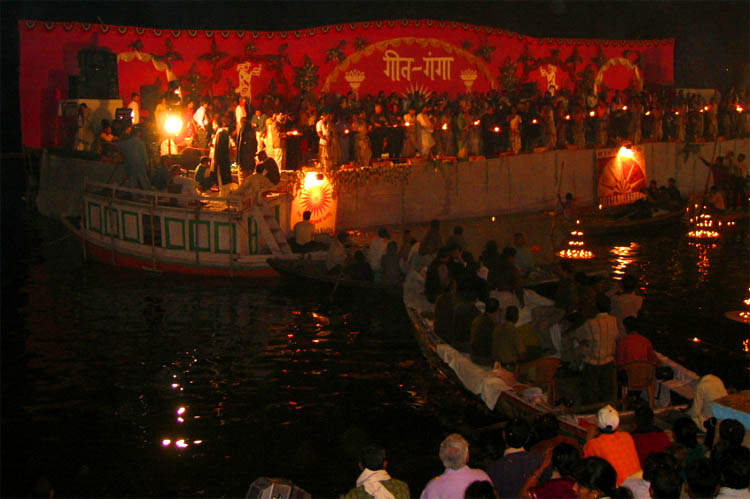
| And finally a religious festival began,
|
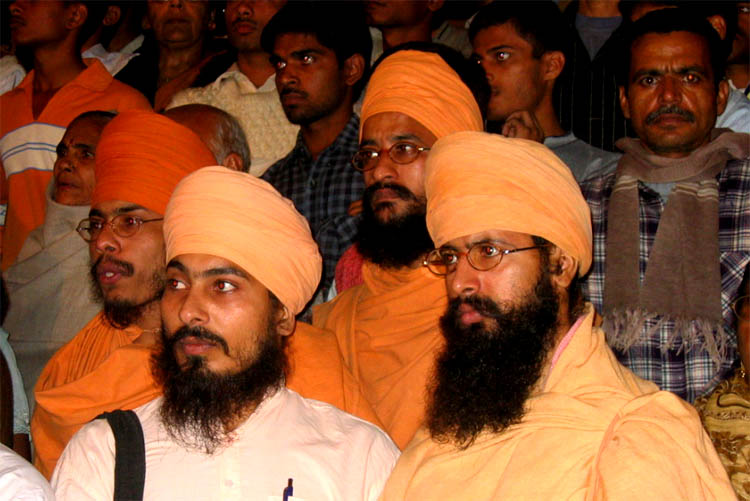
| listening to a speech, I do not understand
|
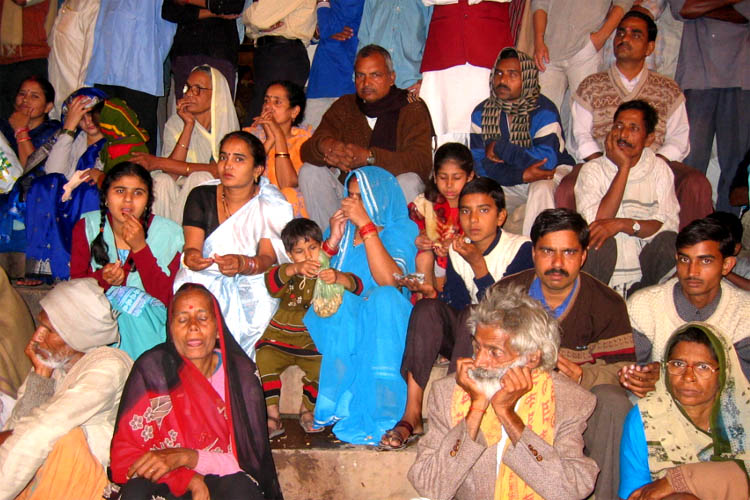
| People are watching from the seating wings
|

| at the priests who are pulling the strings
|

| accompanied by young girls
|
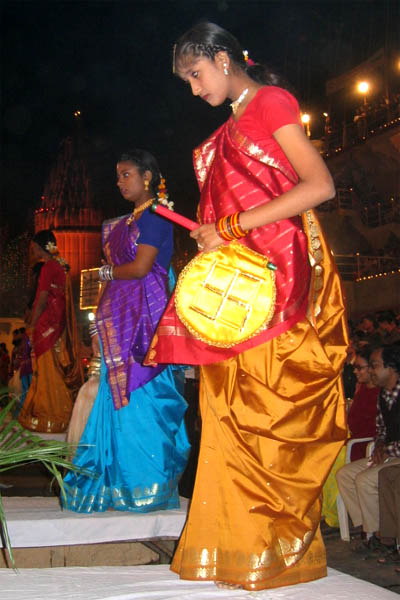
| doing some kind of rituals
|
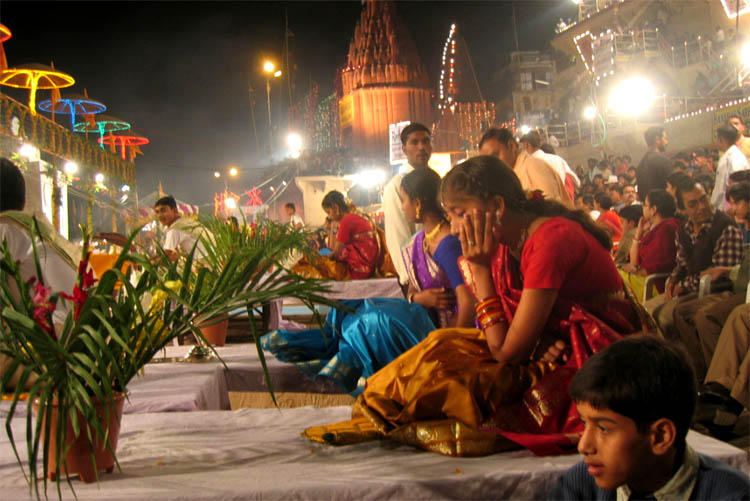
| and then some contemplation
|

| looking at me with consternation?
|
Next day early morning back to the ghats in the dark. The taxi brought us to the end of the Ganges, the lower part. From there we also could walk up in one direction to the northern portion. But first we took a boat to watch the people from the water, with caution.
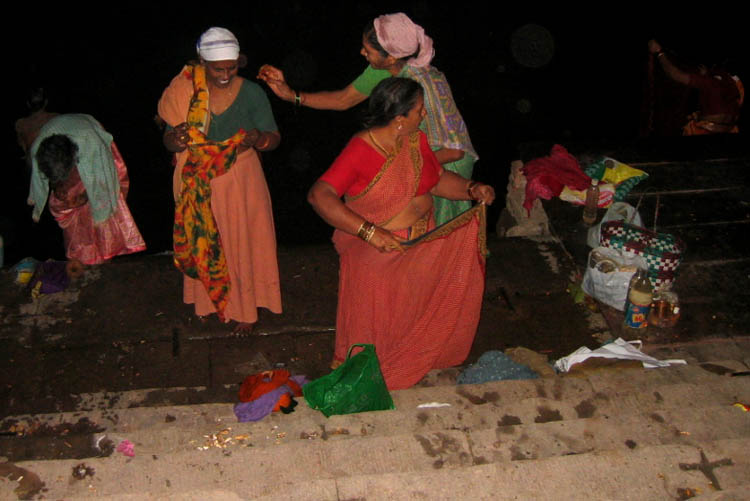
| Women undressing at the Ganges in the early morning
|
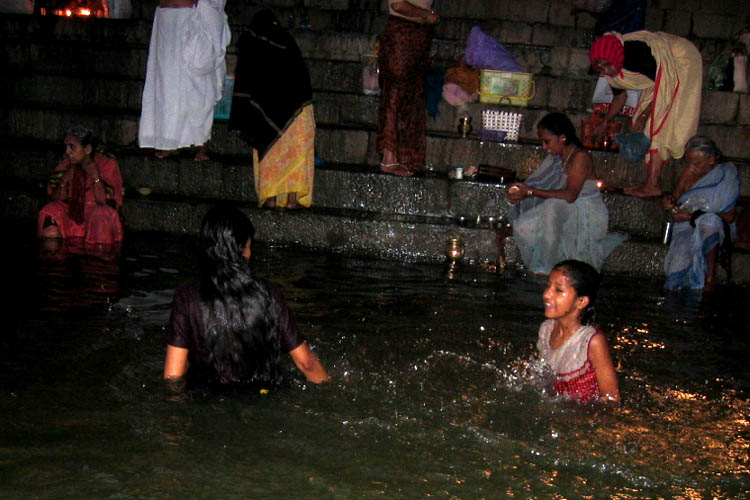
| to take a bath again, while I am still yawning
|

| Women and men, the oldest and the youngest
|
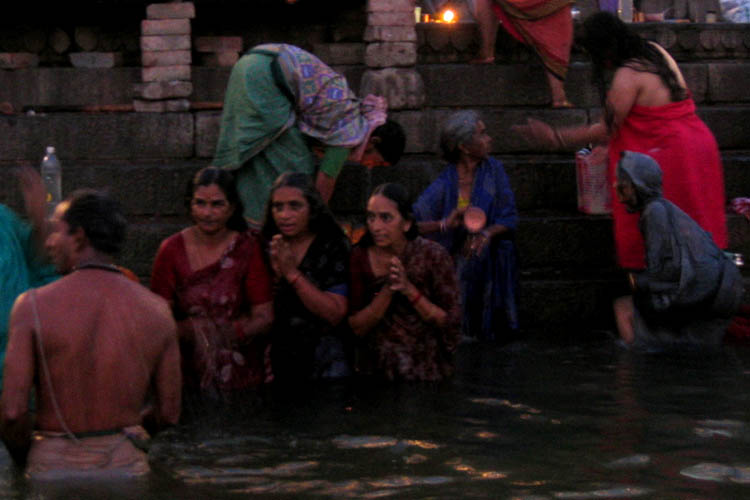
| everybody prays in the Ganges
|
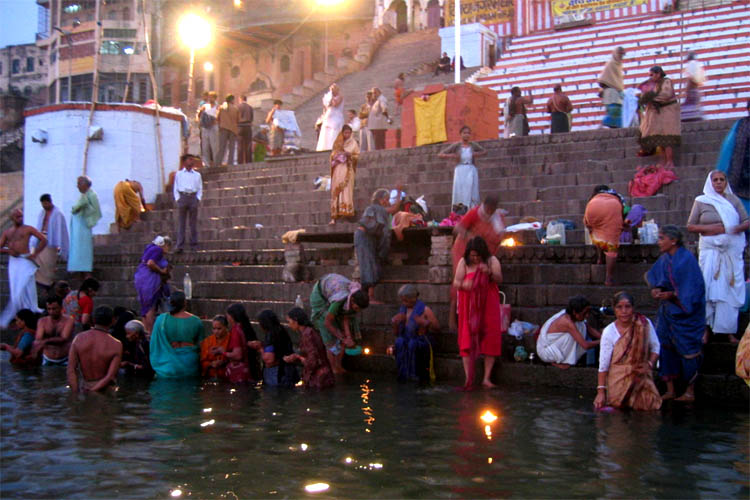
| One ghat is still illuminated with a light
|
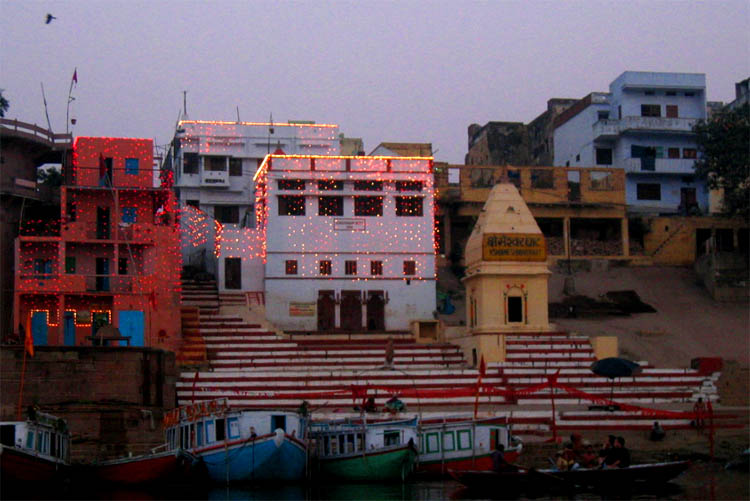
| but soon you see it in the morning light
|
Now we can see more in the daylight. Unfortunately the sun is not fully shining, so the photos look a little bit fade. The old splendor of the Maharaja's palaces (still called ghats - like the Shivala Ghat of the maharaja of Varanasi - are part of the ghat leading to the river) can still be admired.
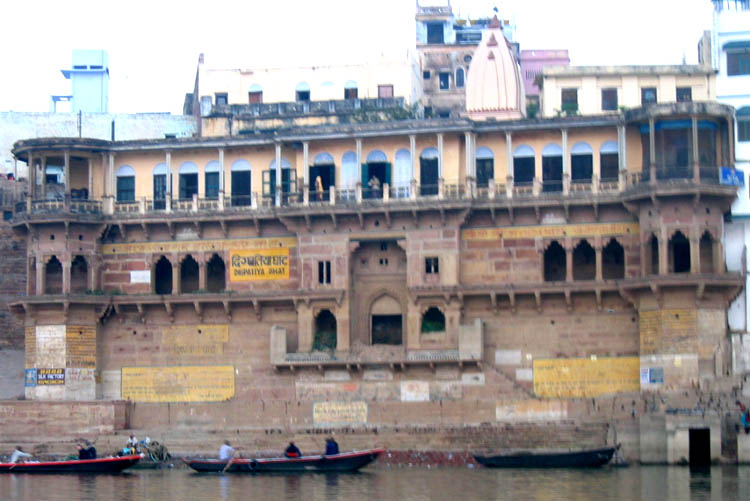
| Old palaces don't look bright anymore
|
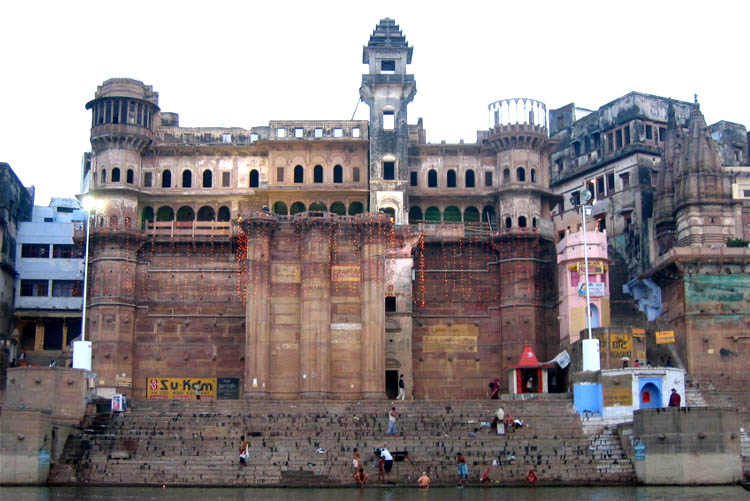
| standing high on the Ganges shore
|

| New temples colored bright
|
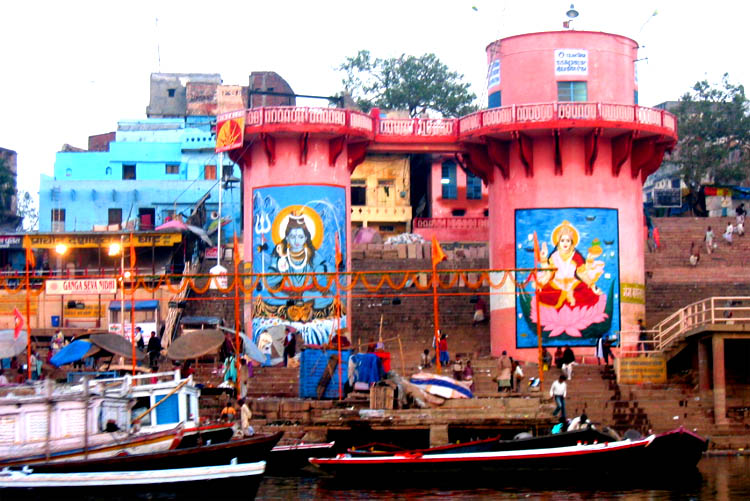
| slowly glancing in the morning light
|
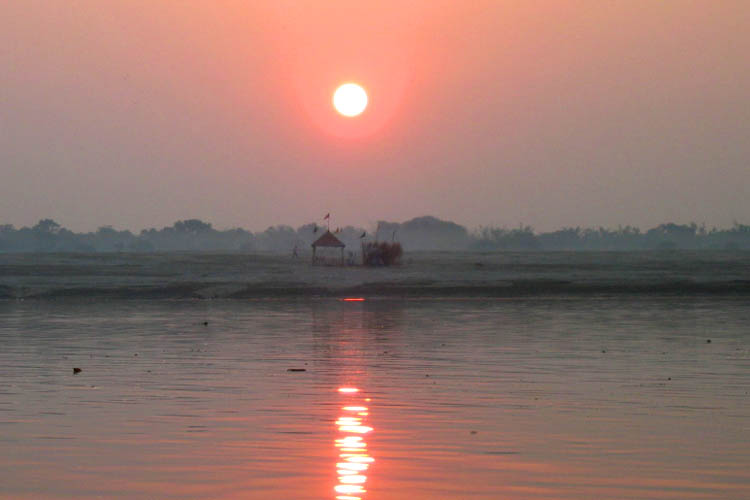
| Over the Ganges, the sun is already long time up
|

| a woman is praying while standing up
|
Sarnath
After we left the ghats we went to Sarnath which is just 10 km north of Varanasi. Buddha supposedly came to this hamlet, after he achieved enlightenment. The Dhamekh Stupa, with a height of 34m, is the most impressive building and still standing, with some refurbishing, of course. King Ashoka build most of this place 200 BC. Unfortunately destroyed by Muslims invaders. Then forgotten until detected by the British in the year 1835, when also the excavation commenced. It has a beautiful garden. The Main Shrine showed the Ashoka Pillar with an old inscription. Adjacent is an excellent Museum. The admission was 100 rupees (or 2 USD).
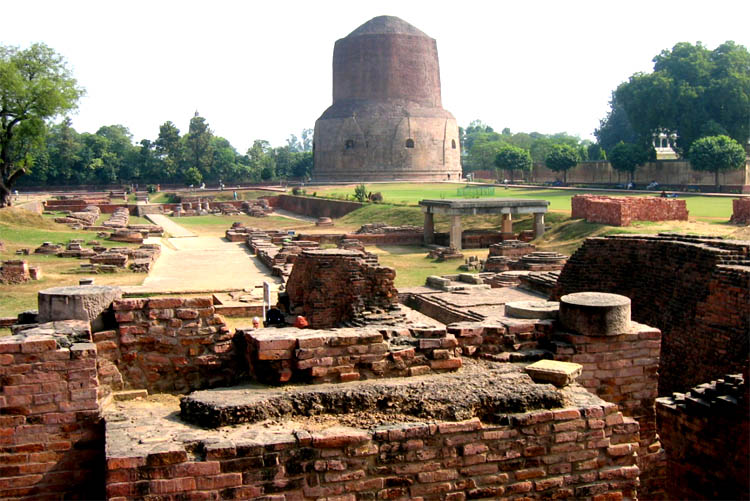
| Remnants of Buddhism are still to be found
|
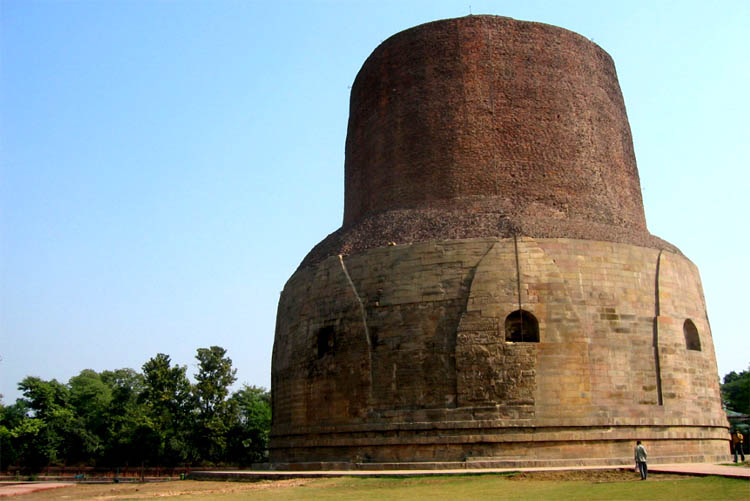
| but in India there are not many around
|
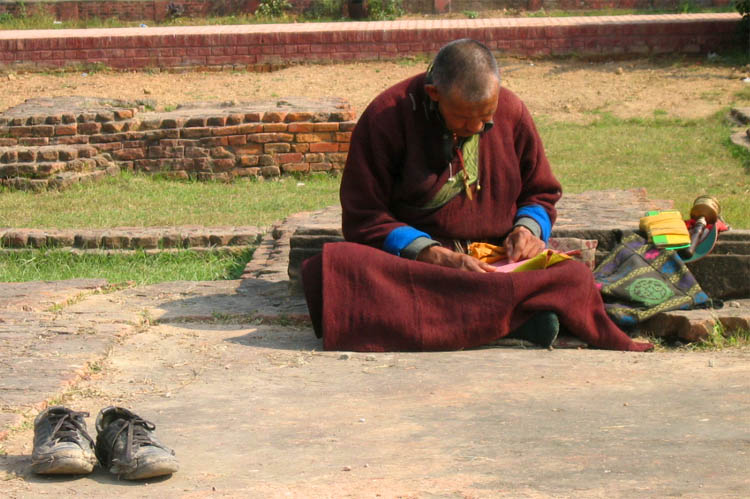
| Still visited by many Buddhists
|

| and admired by the many tourists
|
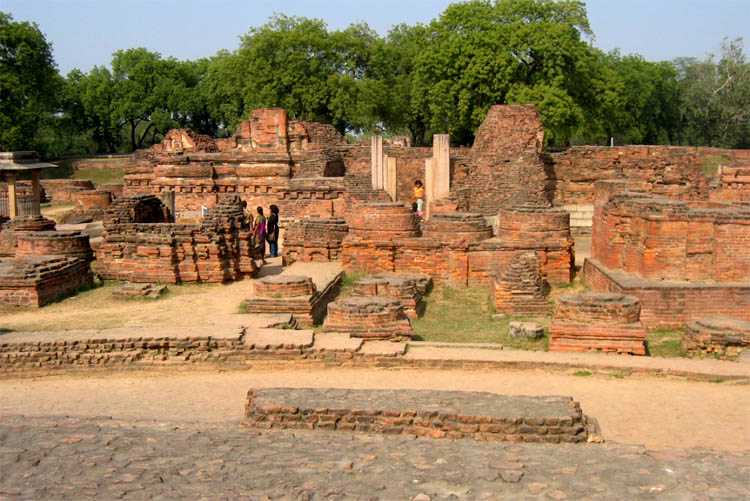
| How old? Any ideas?
|

| Looking at you are 2200 years
|
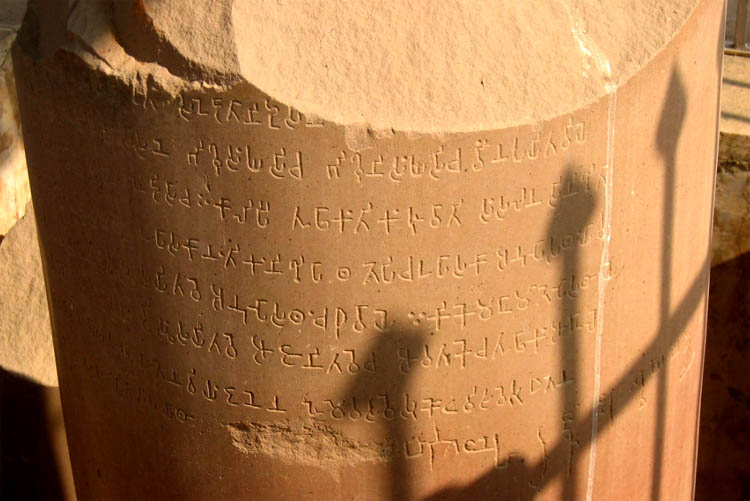
| Can anybody still read this right?
|
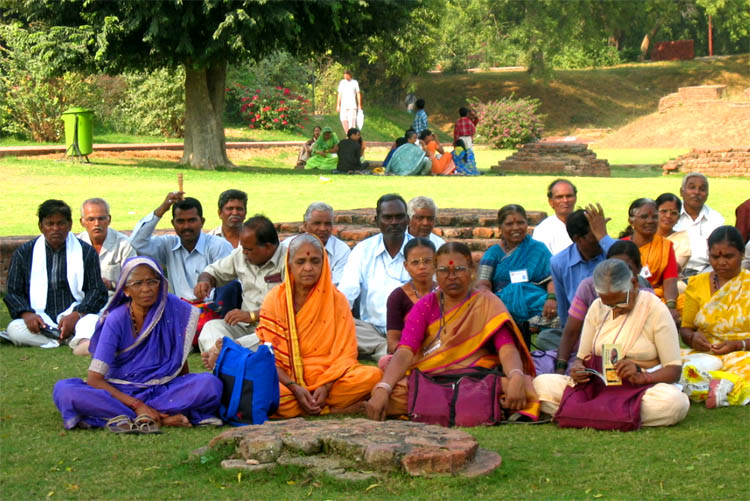
| Indians also worshipping this site
|
Next to the old Buddhist site we had a glimpse at a modern temple, nice and bright.

| Indians mainly visit a Hindu place
|
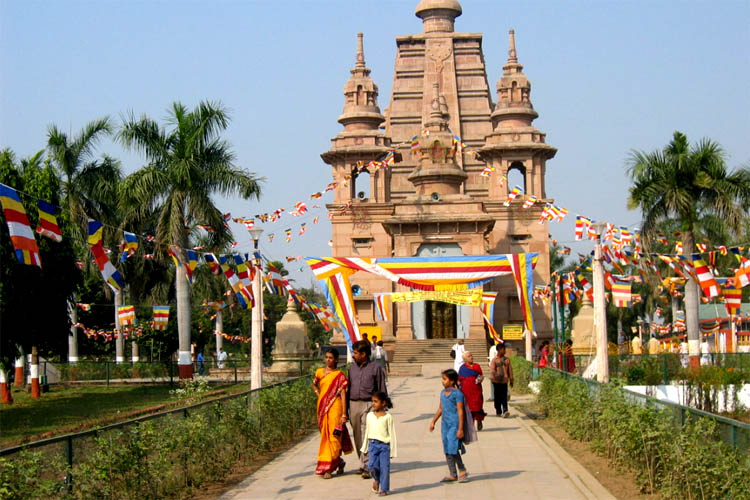
| especially during the holidays
|
While we went back to our hotel we passed two weddings going on in two of the better hotels. With so many Indians around there are always a lot of weddings happening every day. And such is one of the most important events in an Indian life. But sometimes accident prone after for the wife, because another dowry for the husband is in sight. Ok, it may be the result of their custom, so we didn't care. While we were standing at the front entrance and tried to get a glimpse inside, we were invited to join the guest crowd for drinks, food and small chats and later on going in the parade.
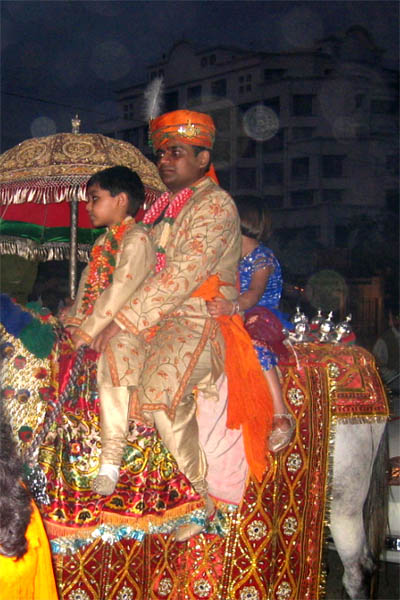
| Indian with son already? of the future wife?
|
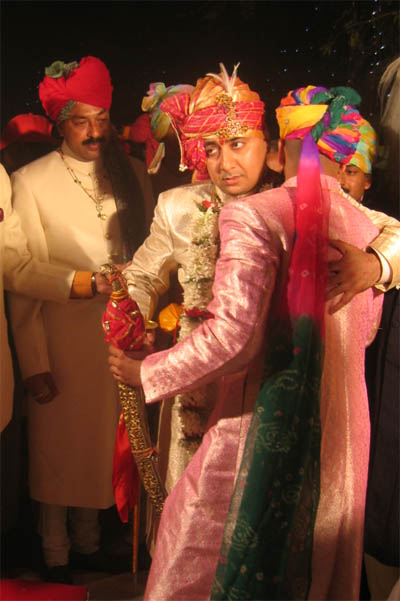
| A wedding is part of the Indian life
|
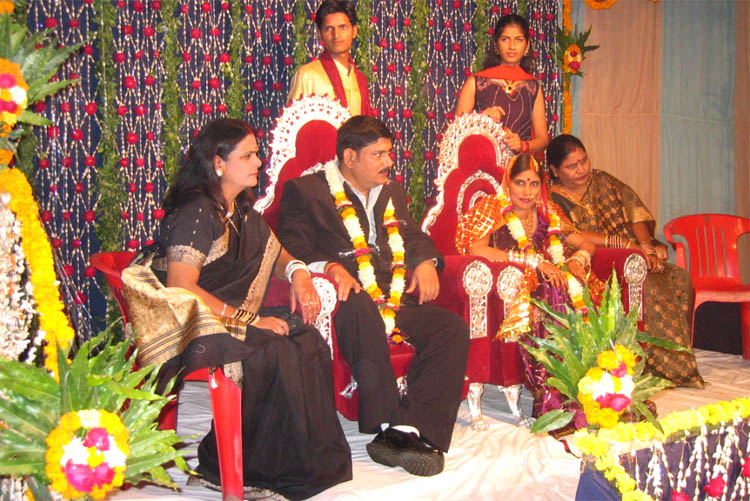
| Bride and groom presented on stage
|

| Guests going on a buffet food raid
|
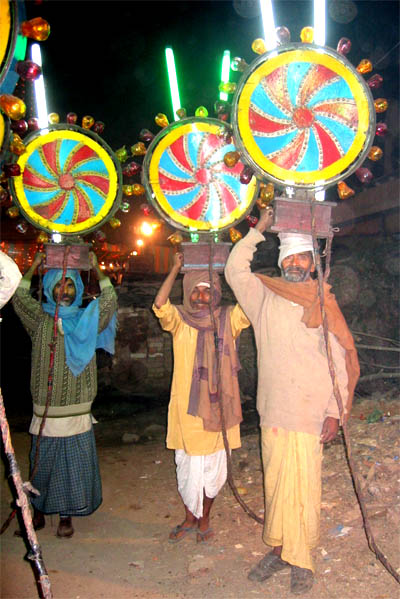
| The wedding parade is ready for the hike
|
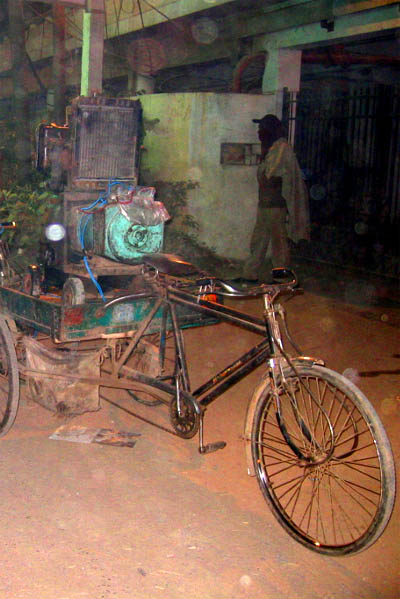
| Power for the lamps will be supplied by the bike
|
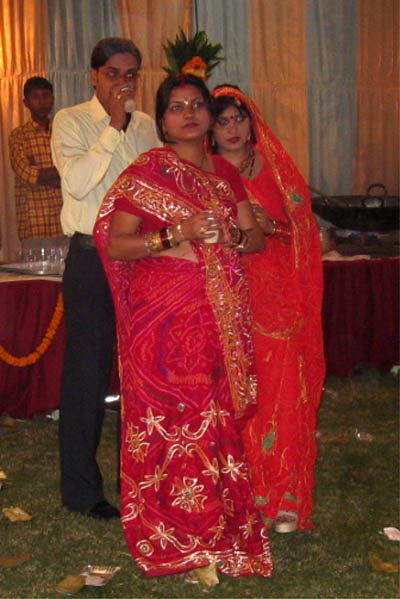
| Some wedding guests are looking perplexed
|
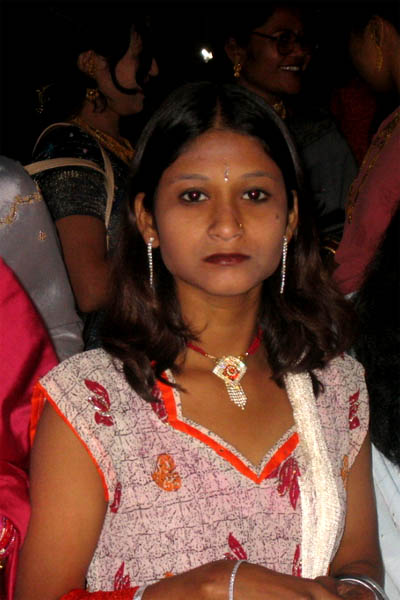
| This girl doesn't know yet what comes next
|
Khajuraho
This town with its temples are famous for some erotic sculptures. Some people already call it pornography, but it is art and antique and 1000 years old. Some may be even disappointed, because there are only a few. Most other engravings just depict "normal" life, if you would declare the various sexual positions not normal. But for the society at that time it was part of their normal life.
And Khajuraho is not the only place in India where I have seen this kind of sculptures. But in modern India and its media there is not such permissiveness, except for the old stuff: all kinds of Karmasutra books can be bought in many book shops and souvenir stalls around Connaught Place in Delhi. But usually the Indian society is very very prudish. Even nakedness is frowned upon (except for some Saddhus - holy men - we saw running stark naked on the road).
Back to Khajurao: Especially the first photos will show some erotica running through some Karmasutra positions surrounded by voluptuous women, the so-called apsaras (heavenly nymphs), similar to the ones you can see in Angkor, no Kamasutra though. The sculptures are about 1 meter high and almost look three-dimensional, just fantastic.

| That's the real Khajuraho art
|

| Need a close up to start
|
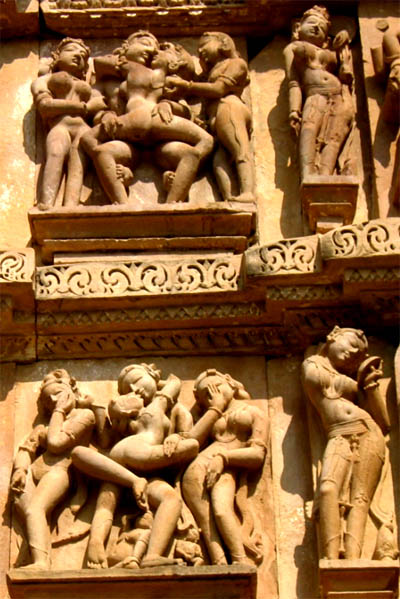
| Want to practise that a little bit
|
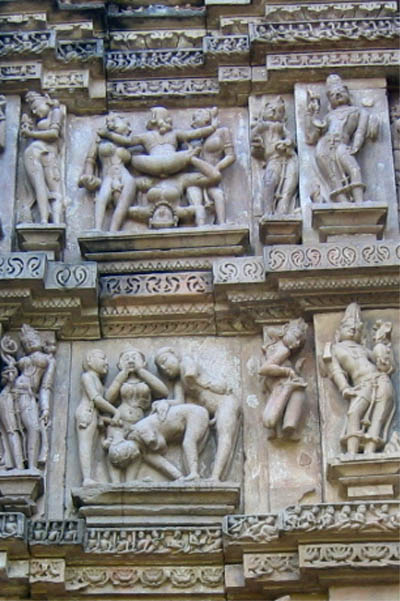
| Don't get pale while looking at it
|
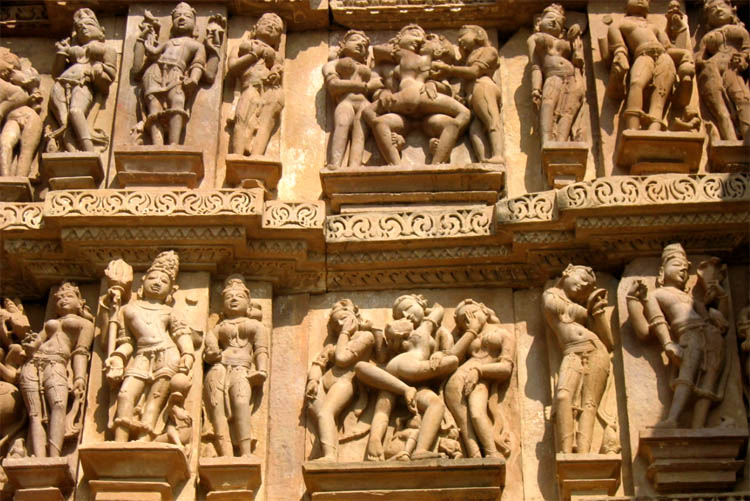
| Embedded as part of life
|
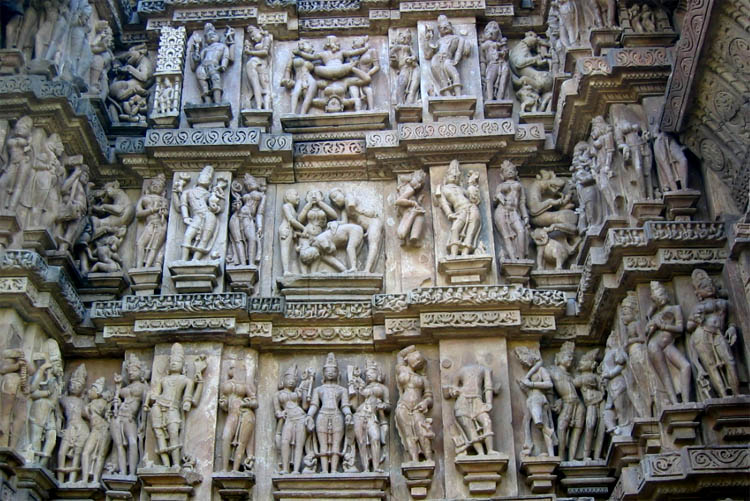
| look away, if you don't like
|
All temples are build by the Chandela Dynasty around AD 1000 but then partially destroyed by the moguls AD 1500. All temples are dedicated to Hindu Gods.

| The temples look terrific
|
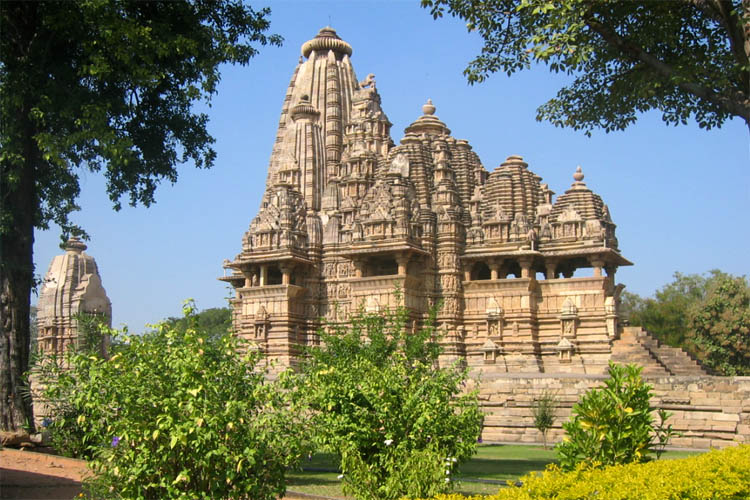
| either way you look at it
|
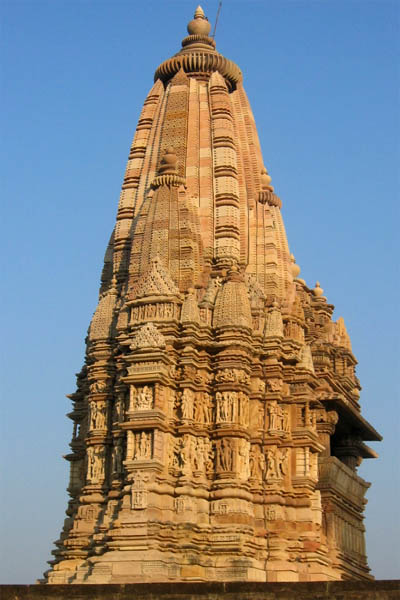
| The size and shape of every temple is majestic
|
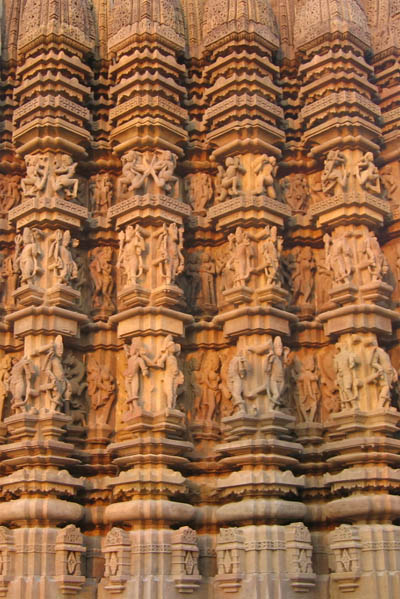
| and all the engraved sculptures are fantastic
|

| Look up at this magnificent temple
|
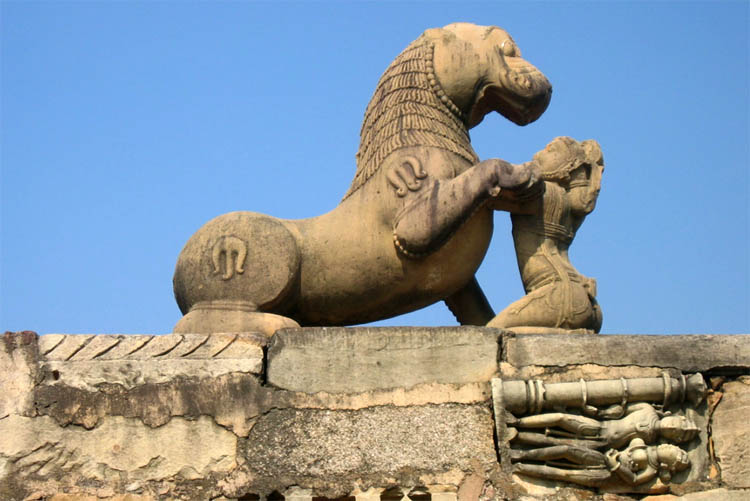
| for these skills a good example
|
And last not least comes the oldest (finished around AD950) but still the best preserved temple: the Lakshmana temple dedicated to Vishnu.
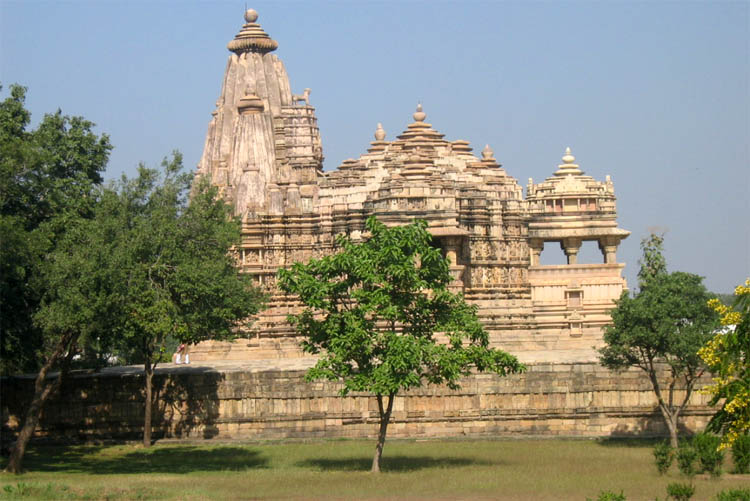
| More temples, not the last
|
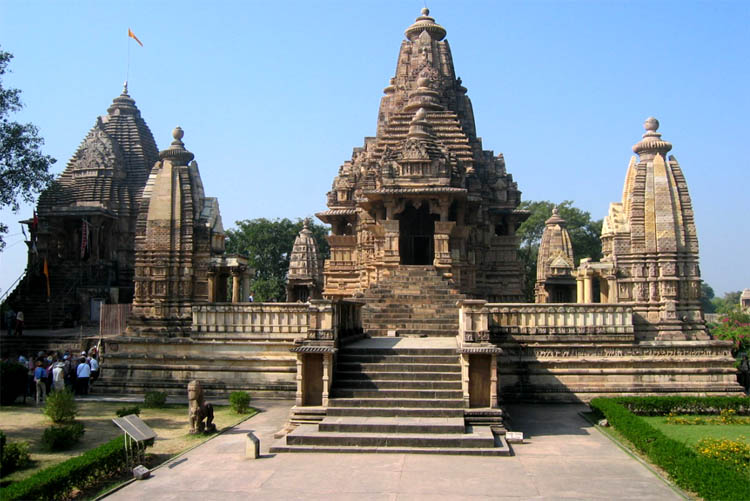
| this has another erotic cast
|
This Lakshmana temple contains the frieze with the most daring erotic sculptures together with more day to day life scenes as it was in the old days.
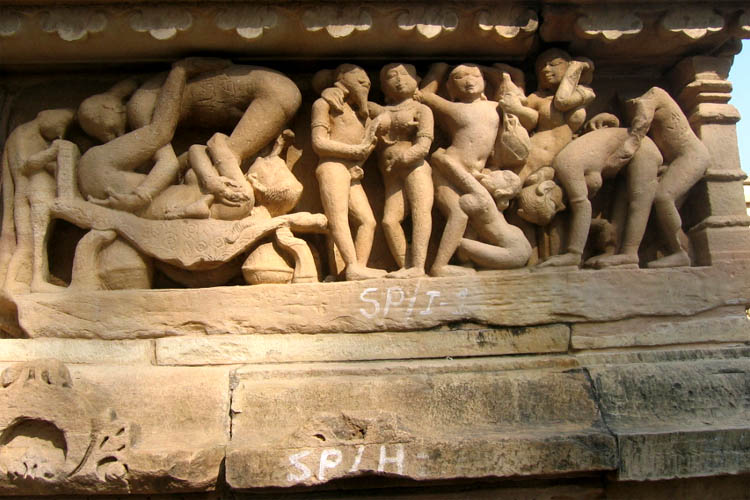
| This shows various positions like in an orgy,
|
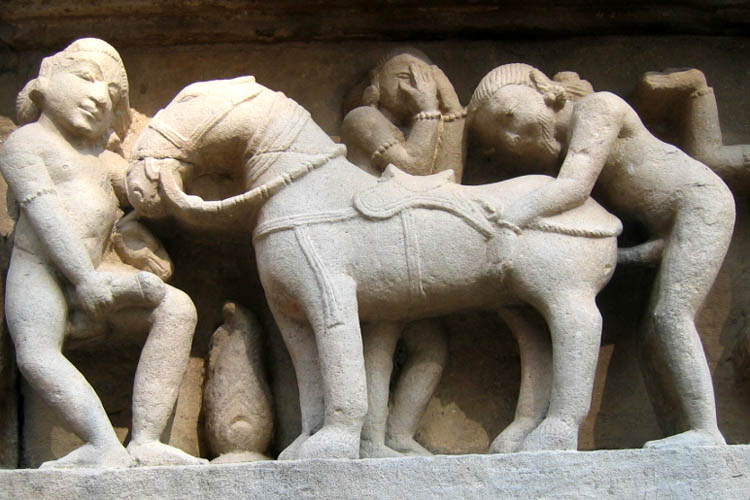
| a lady can only cover her face before so much sodomy
|
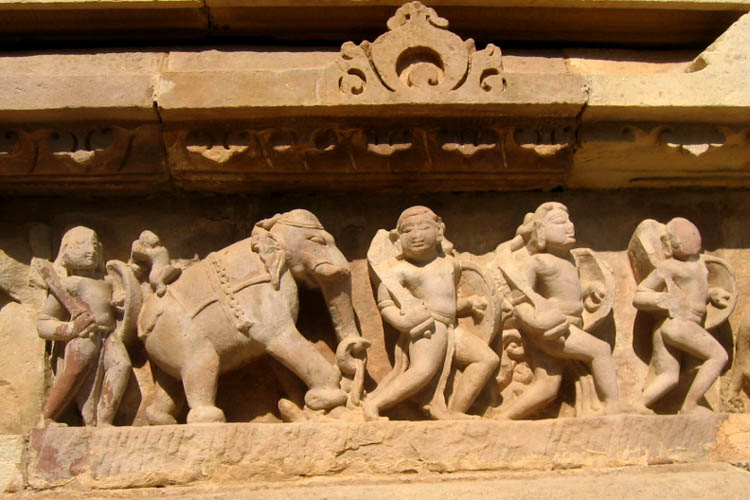
| Also working with elephants was part of life
|
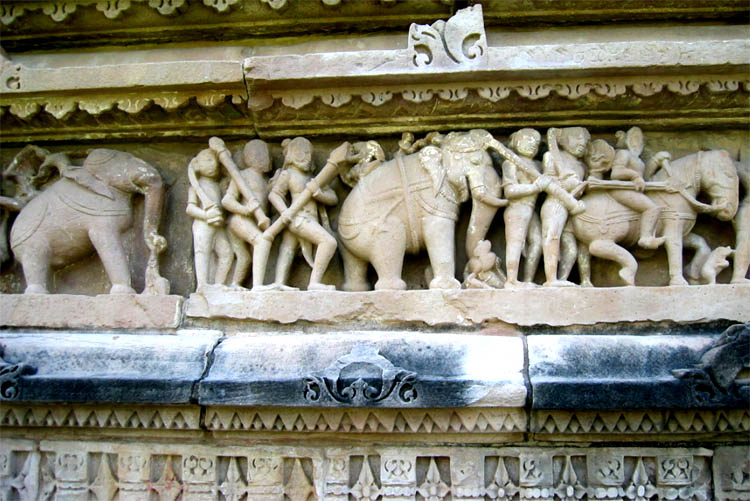
| also going to war with them after a strife
|
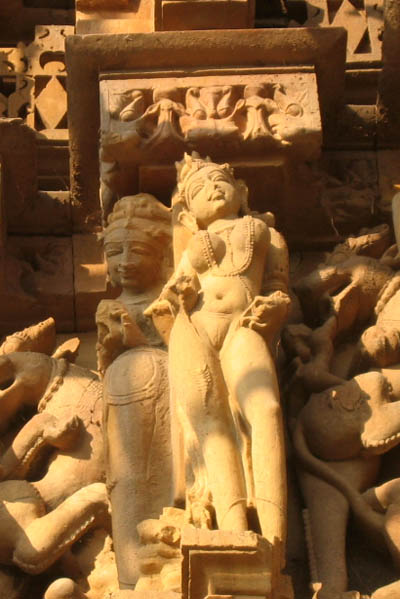
| These leggings should give Armani an idea for the next fashion craze
|
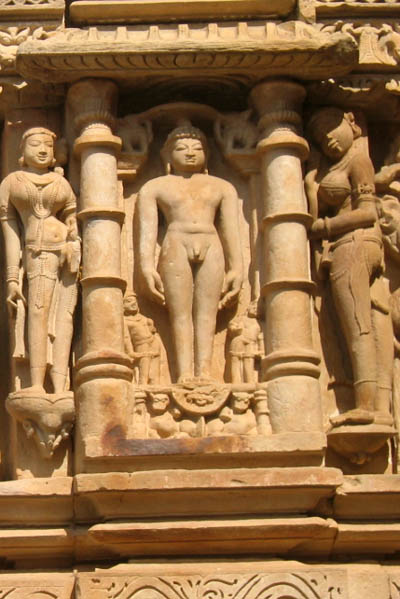
| Buddha is already naked, and men would like to see that on a catwalk stage
|
OK, ok, now you want to know how to get there. It's not straight forward, because Khajurao does not lie on any of the main routes. The only direct connection with Delhi and Varanasi is by plane. But we did it the hard way.
In the late evening (almost midnight) of November 27 (yes, we stayed only one night in Varanasi and still done and seen so much) we took the train from the Junction Station and paid 1099 rupees (20 Euro) for two (yes, it's odd) to arrive in Satna after around seven hours next early morning. From there we went by bus for 50 rupees to Khajuraho after we have waited some time until the bus was full.
After another 5 hours we arrived in the new town where all hotels are mainly located on the main street. Thus it was easy to look around from one hotel to the other until we found and stayed in the
Hotel Harmony
Main Street
Khajurao
|
The room had hot water with a window looking out to the inside garden. The rate was 200 rupees (3.50 Euro).
As soon as we checked into the hotel (it was still early afternoon) we strolled along the main street in the direction to the main temple complex, called the Western Group located very close to town. The entrance fee was 5 USD, and that was worth it, with all the renovation done to those temples. All of this you have already seen in the previous photo series.
Every night there is even a Sound and Light show, but we had enough from our temple sight seeing tour on our first day here and just watched the other life in the streets and after dinner went to bed early dreaming of all those apsaras.
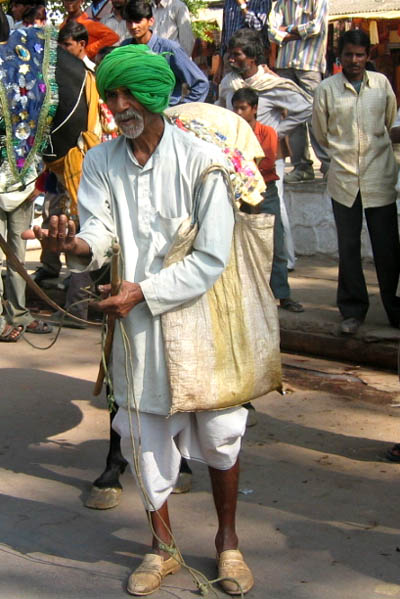
| The price of a camel is still negotiable
|

| Those beards may become fashionable
|
Next day we rented bicycles to visit the old village with temples of the Eastern Group, divided into 2 groups: two Jain temples and four other temples, which are scattered around the village. One of the Jain temples is called Parsvanath and is one of the finest in Khajuraho. It was originally dedicated to Adinath. The other, smaller one, is called Adinath and also dedicated to Adinath, the black image of Parsvanath, thus proof that this is not Hindu but Jain. Complicated? Read the guidebooks and you get more confused.
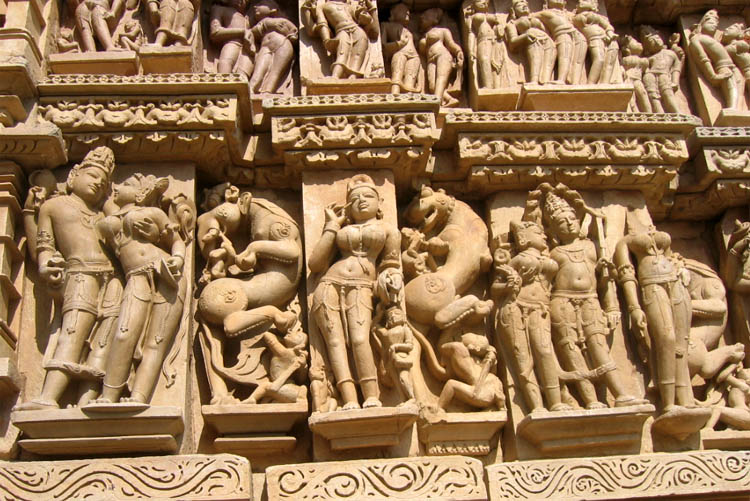
| Outside Parsvanath?
|
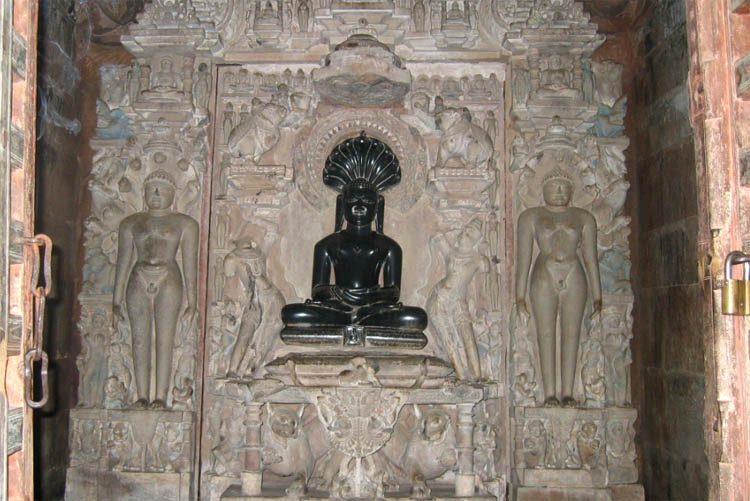
| Inside Adinath?
|
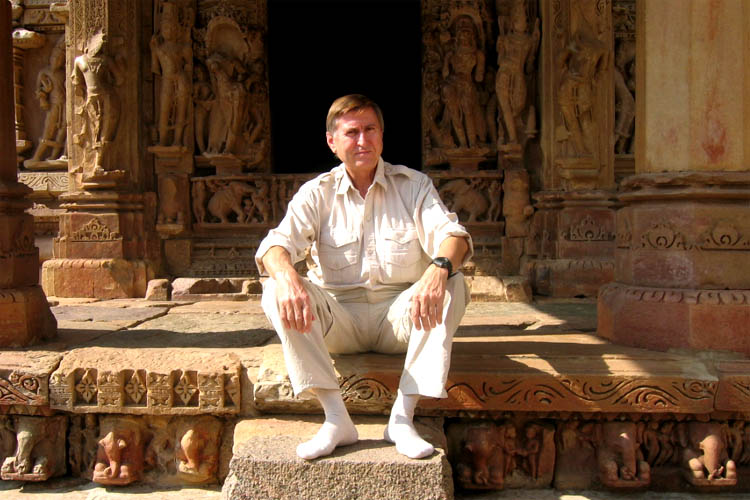
| Resting before Adinath, in one of the other compounds
|

| it's hard not to get attracted by the female rounds
|
We met one of the locals, or better he met us. Said that he is a student and wanted to practice English with us and offered to show us to the other temples. I told him that we do not need a guide and we are not going to pay anything for that. Then all of a sudden we passed a building and he explained that this is a school, which can only be maintained with donations only and whether we would also like to give some money. It was a normal weekday in the morning, but no children around. When we did not donate anything he did get naughty and cursed after us. Ok, a common scam, which is practiced in many tourist spots in India. As I have explained in my previous travel reports: do not give any money for nothing but rather donate to
SOS Children Villages (SOS-Kinderdorf). It was easy to find our own way around, especiaily with the map we did get from the tourist office.
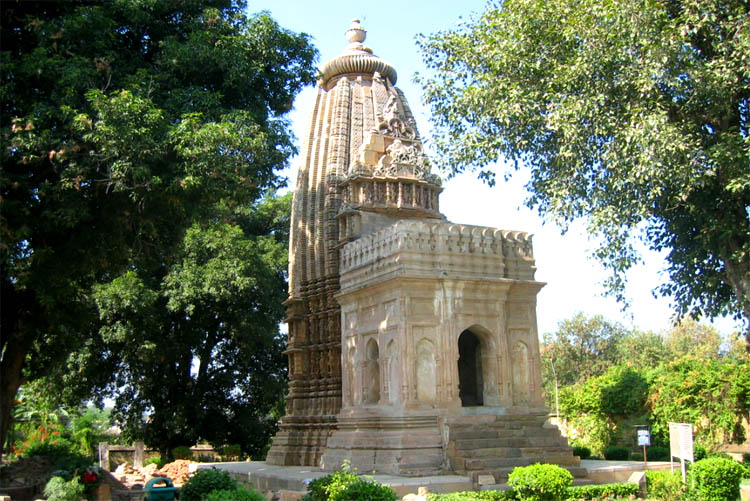
| This temple is beautifully ornamented
|
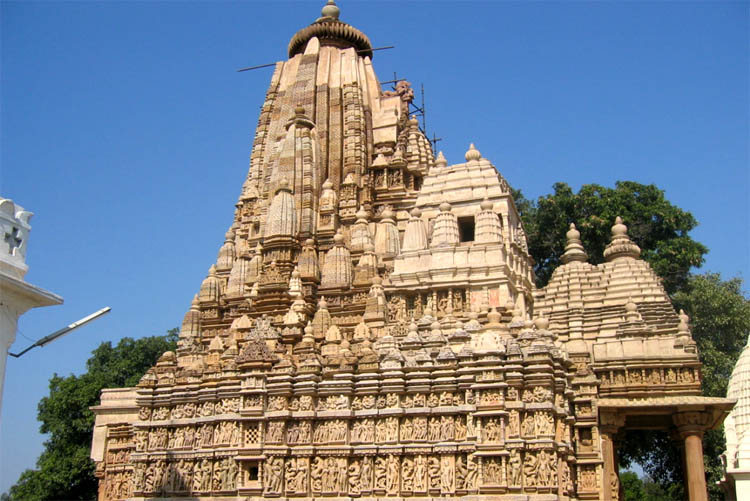
| Another one here is still being restored
|
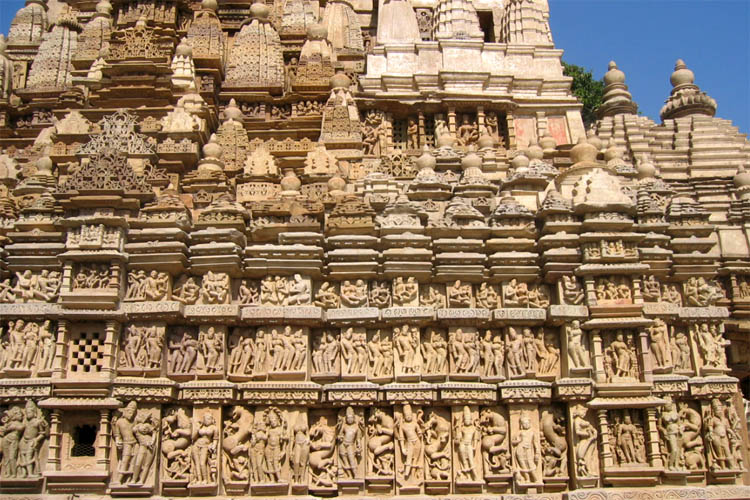
| The beautiful sculptures look like new
|
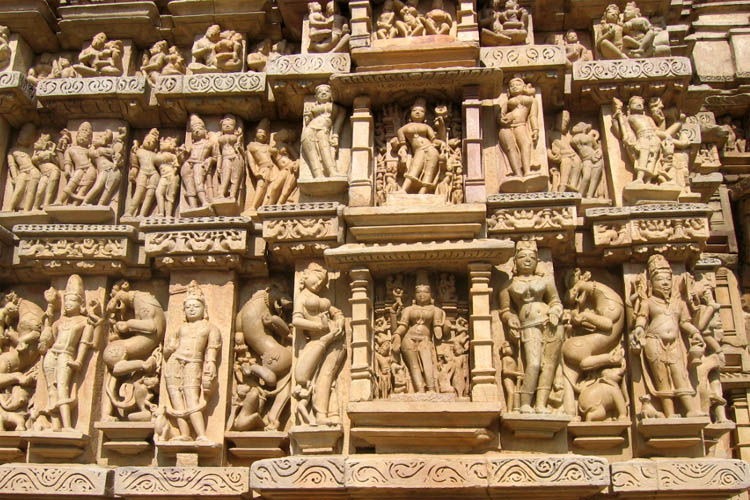
| The close-up proves it very well too
|
It was easy to find our next destination: the southern group, but with some bycicling effort through the countryside. It was worth for the exercise and the people we met but not so for the only two temples which were in rather bad condition.
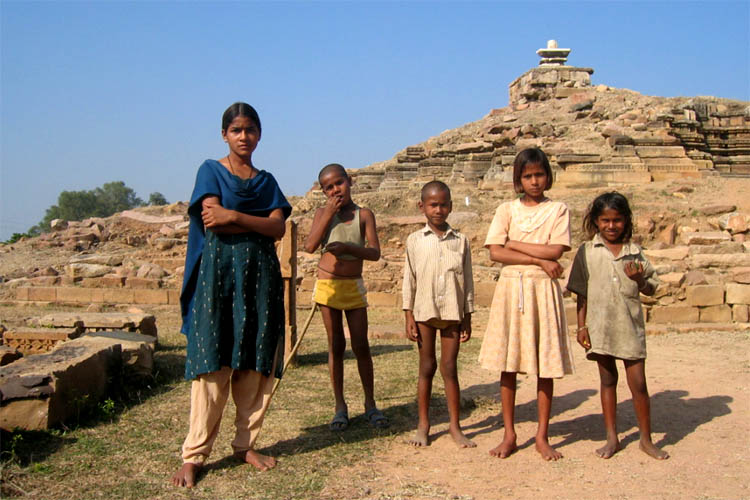
| Village children brought us to a stop
|
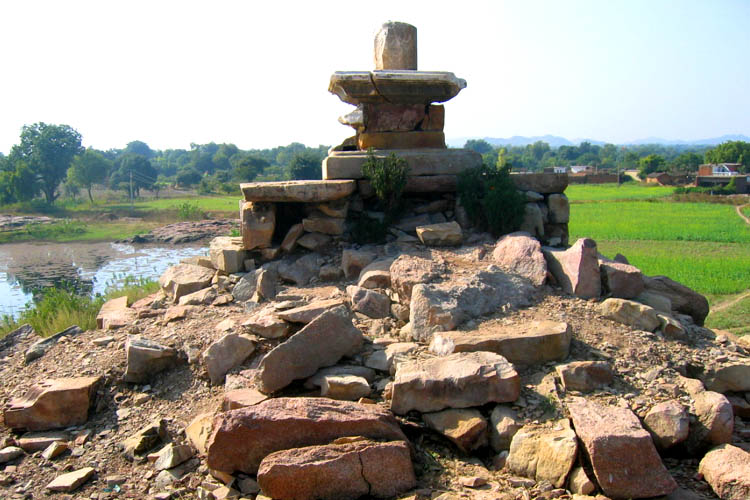
| but they can not hinder us to climb to the top
|

| Women can carry sacks on their heads very well
|
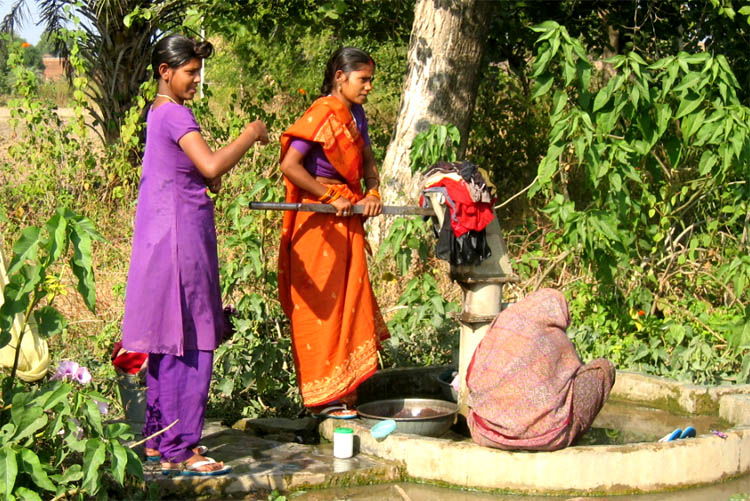
| and other women doing the laundry at a well
|
Ok, that was the first half of our trip to India. If you want to continue, just click on
Part II
As it was said before and will be said again: If you want to know more all about the places we have visited, then just look up any of the many guidebooks or in the internet.
| 